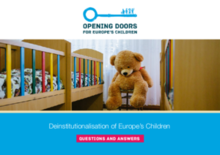This resource provides quick answers to some of the frequently asked questions about the transition from institutional to family- and community-based care for children, also known as deinstitutionalisation (DI). The publication is designed to answer in a simple and user-friendly way what are institutions for children, why close institutions and spend on deinstitutionalisation, what EU and the national governments can do to improve their lives and to better protect the rights of this vulnerable group of children.
This learning guide will have a strong appeal for European policymakers considering that the issue of deinstitutionalisation affects not only children but has a long-term impact on the public purse and society as a whole. Despite the wealth of evidence on the harmful effects of institutionalisation, hundreds of thousands of children across Europe continue to be placed in poor quality, segregating residential care facilities. The publication can also serve as an entry-point resource for practitioners and organisations in their advocacy work towards national and EU-level policy makers.
“We need to stop taking children out of mainstream society and putting them into institutions for children. When we put children in institutions, we are failing them and ultimately creating a generation of neglected children. If we want to ensure that children are at the heart of Europe’s priorities, deinstitutionalisation must become a vital consideration for European policy,” the guide says.
To accompany the guide, the Opening Doors for Europe’s Children campaign has prepared an online quiz to test the knowledge and tackle some of the tricky questions on deinstitutionalisation. In 2018, a working paper will be released as a companion resource for policy and decision makers, treating the issues raised in this learning guide in more detail.

